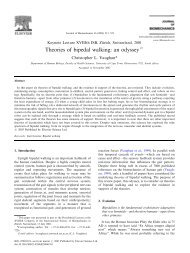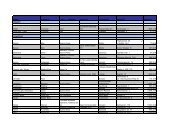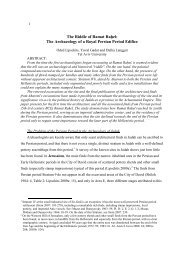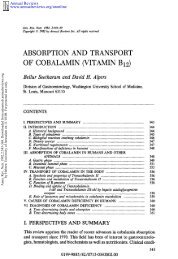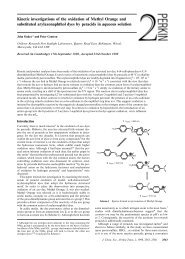The Cemetery of Azor and Early Iron Age Burial Practices
The Cemetery of Azor and Early Iron Age Burial Practices
The Cemetery of Azor and Early Iron Age Burial Practices
Create successful ePaper yourself
Turn your PDF publications into a flip-book with our unique Google optimized e-Paper software.
Ben-Shlomo<strong>The</strong> <strong>Cemetery</strong> <strong>of</strong> <strong>Azor</strong>itself, were filled with soil <strong>and</strong> s<strong>and</strong>; eventually,the vessels around the jar <strong>and</strong> jar basalt coverwere placed. Near the base <strong>of</strong> the jar, <strong>and</strong> tothe east <strong>of</strong> it, an articulated skeleton was found,with its head to the west, probably a disturbed LBIIburial (<strong>Burial</strong> D68, Fig. 11: Section 2; Fig. 13).Outside the stone structure a skeleton <strong>of</strong> a horse ora camel was reported; its relation to the tomb isquestionable.Inside the jar (Fig. 18:5) a layer with burntskeletal remains <strong>and</strong> dirt was found (Dothan1989, 169, fig. 19); above this were placed a potteryflask, a bronze bowl <strong>and</strong> a golden ‘mouthpiece’(Fig. 21:1, 4; Dothan 1989, 169, figs 15–16). Severalsherds <strong>and</strong> shells were also found in the jar.According to the initial anthropological analysis(N. Haas) the remains were <strong>of</strong> an adult male aged40–45 (‘brachicephalic’ skull), 172 cm high, <strong>and</strong>adolescent male aged 12–16 (also ‘brachicephalic’skull) together with bones <strong>of</strong> birds <strong>and</strong> householdanimals as pig. Later, only a skull <strong>and</strong> a jawwere recovered (Dothan 1989, 69–170, figs 20–21),<strong>and</strong> according to P. Smith the skull was <strong>of</strong> anadolescent <strong>and</strong> the jaw <strong>of</strong> an adult. Deformationsin the skull indicate heating <strong>of</strong> about 250uC <strong>and</strong>the jaw indicates uneven temperatures <strong>of</strong> heating.Generally, the remains indicate a relatively lowtemperature <strong>of</strong> cremation (Dothan 1989, 170). <strong>The</strong>finds from outside <strong>of</strong> the burial jar include fourjugs (Fig. 18:6). Tomb D63 is unique at <strong>Azor</strong> fromseveral aspects, such as the cremation, the stonestructure, the shape <strong>of</strong> the jar <strong>and</strong> ‘exotic’ finds, suchas the bronze bowl <strong>and</strong> golden mouthpiece.Cremation burials with such structures occur in<strong>Early</strong> <strong>Iron</strong> <strong>Age</strong> Torone in northern Greece(Papadopoulos 2005, e.g. Tomb 104, 181–82, pls210–15), but are not known in the Levant. <strong>The</strong> jarused in burial D63 (Fig. 18:5) is also quite unique; itwas rarely found outside <strong>Azor</strong>.<strong>Burial</strong> D62 is located 2 m to the north-east <strong>of</strong>Tomb D63 <strong>and</strong> was comprised <strong>of</strong> an upright st<strong>and</strong>ingjar with skeletal remains within; the mouth <strong>of</strong> the jarwas covered with a bowl; adjacent to it a complete jugwas st<strong>and</strong>ing upright <strong>and</strong> probably also related tothis burial. Several other vessels were uncovered inrelation to this burial together with jar fragmentssimilar to those <strong>of</strong> Tomb D63. <strong>The</strong> skeletal remainsfrom this burial, albeit only partly recovered, showclear indications <strong>of</strong> cremation <strong>of</strong> an individual olderthat 10 years. <strong>The</strong> position <strong>of</strong> the burial vessel, itscovering, <strong>and</strong> the proximity to Tomb D63 strengthensthe possibility that this burial was also acremation burial. <strong>The</strong> pottery from the burialincludes two Philistine Bichrome kraters, a completecarinated red-slipped bowl (Fig. 18:3), a complete jug<strong>and</strong> a double-flask vessel (Fig. 18:13). Another burial(D9) with evidence <strong>of</strong> an adult individual (Ferembach1961, 85) <strong>and</strong> traces <strong>of</strong> blackened earth might havebeen a cremation burial.In the past the appearance <strong>of</strong> cremation burials at<strong>Azor</strong> was related to a new wave <strong>of</strong> Aegean influence(Dothan 1982, 57; Dothan 1989; Dothan <strong>and</strong> Dothan1992, 115–17; Gilmour 1995, 167–69), <strong>and</strong> thecremation burial at <strong>Azor</strong> was also mentioned as theearliest cremation in the southern Levant (Dothan1961a; 1989; Dothan <strong>and</strong> Dothan 1992, 115–16), yetseveral examples do appear in the Bronze <strong>Age</strong>,possibly at Jericho <strong>and</strong> Tell Beit Mirsim (Bloch-Smith 1992a, 179: Gilmour 1995, 167–69). Cremationis <strong>of</strong>ten considered as an alien element in the Levant(e.g., regarding its appearance in the LBII at the sites<strong>of</strong> Alalakh (Woolley 1955, 202) <strong>and</strong> Hama (Riis 1948,44; see Bienkowski 1982, 86–87)). At the LBII templeat Amman Airport burnt human bones are also likelyto represent cremation (Herr 1983, 23; Little 1983,49–50). Note, that at this site a golden mouth piecewas found also (Hankey 1995, 175, fig. 3:5872, 5878),<strong>and</strong> thus there is an interesting analogy with TombD63 at <strong>Azor</strong>.5. Partly built tombs with multiple primaryburials are made <strong>of</strong> three stone walls defining anarea <strong>of</strong> about 3–2 6 2 m wherein the bodies <strong>and</strong>artefacts were laid. Two such structures wereuncovered: Structure A dating to Phase III <strong>and</strong>Structure B (Tomb D79) in Square J10 dating toPhases III (with possible evidence <strong>of</strong> an earlierstage as well). <strong>The</strong> structures contain together atleast 23 burials, that were relatively rich with burialgoods.<strong>Burial</strong> Structure A (Fig. 14) is located in Sqs M9–M10 <strong>and</strong> is comprised <strong>of</strong> three stone walls creating arectangular structure with an opening to the southwestmeasuring about 2 . 7 6 2 . 4 m. <strong>The</strong> walls werebuilt <strong>of</strong> large kurkar blocks <strong>and</strong> were st<strong>and</strong>ing at least70 cm high; this was probably a defined burial spacewith an internal width <strong>of</strong> 1 . 7 m. It contained four toseven separate burials, in several stages <strong>of</strong> burial.When new burials were placed some <strong>of</strong> the bones <strong>of</strong>the previous burials were moved <strong>and</strong> thus only thelatest burial could possibly be found in articulation.Nevertheless, according to the remains found it seemsthat the bodies were laid in a relatively uniform eastwestorientation, all in a supine position. <strong>The</strong>structure itself overlies earlier Phase IV pit burials,which contain late <strong>Iron</strong> I finds. Notable finds fromthese burials include ‘black juglets’, Black on Red40 Levant 2008 VOL 40 NO 1



